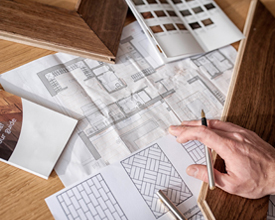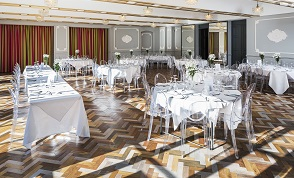We are confident that if you choose one of our wood flooring options that is suitabale for use with underflooring heating, and and follow our simple guidelines below alongside the rest of our installation guide, you can successfully combine Broadleaf wood flooring with underfloor heating.
The following advice is the result of nearly 2 decades of experience supplying wood flooring for use with underfloor heating. It covers the system types most commonly used by our clients, but underfloor heating is an evolving industry and so if there is any conflict between our recommendations and those of your underfloor heating supplier, or you are planning to use a system not covered below, please contact our technical team at technical@broadleaftimber.com, who will be glad to help resolve any queries or offer specific advice as required.
System Temperature
The surface temperature under wood flooring must never exceed 27°C. If underfloor heating is to be fitted under wood flooring, the system must therefore be designed to ensure that this is the case. If your system is being designed for an individual project, make sure that the supplier is aware that a wood floor is to be fitted over it so that they can do this. We would strongly recommend the inclusion of a combined floor / air thermostat, which is not an expensive addition, but which overrides the system if for any reason the maximum floor temperature is reached and protects the floor. Where an off the shelf system is being used, and there is less scope to control the surface temperature under the wood flooring by specification, a floor / air thermostat should always be used.
Product
Next, you need to choose a product that is suitable for use over underfloor heating. Within the Broadleaf range this shouldn't limit you as most of our floors have several compatible options. For details check either the UFH column in the pricing tables on our product pages or our
flooring selector.
Please note that solid plank floors marked as suitable for underfloor heating will need to be rekilned for this purpose and that there is a small additional charge for this which will be shown separately on your invoice.
If your underfloor heating system is being individually designed, make your supplier aware of your choice of wood flooring and proposed fitting method so that these can be accommodated or any issues resolved. If you are using an off the shelf system, check that your choice of wood flooring complies with any technical requirements and if not, consider any alternative system, or contact us to discuss alternative product options.
Bear in mind that if wood flooring is installed over an underfloor heating system designed for ceramic tiles, the room my not reasch the desired temperature or may take longer than expected to do so. SImilarly, if it is fitted over a system designed for carpet, the temperature under the floor my regularly exceed the 27°C maximum and cause problems with your wood flooring.
Site Preparation
As with any other wood flooring installation, first make sure that the site and subfloor meet the basic criteria laid out in the
Site Preparation section of our installation guide.
The underfloor heating must then have been run for 3 weeks before the timber is delivered. Set the thermostat to normal room temperature unless the ambient temperature is too high for this to activate the thermostat at this level. In this case, raise the thermostat temperature so that the heating comes on to warm the room. Although this may cause some discomfort in the summer months it is vital to ensure the evaporation of latent humidity in any plaster or screed that might otherwise be absorbed by the floor at a later date.
At this stage, if you have a water system, make sure that the water temperature at the manifold is set to the specified temperature (this is normally 40°- 45°C for wood floors but check with your supplier). In all systems make sure that the floor thermostat (see System temperature section above) in any combined thermostat has been set to be master (overriding any air thermostat) and with a maximum of 27°C.
Timber should then be acclimatised as normal with the heating set at normal room temperature.
Fixing Methods For Water Systems Set In Screed
Broadleaf 105mm & 150mm Solid Oak Flooring that has been re-kilned or Strata Engineered Oak Flooring can be nail fixed over this type of system.
To do this either battens will need to be set into the screed, or it will need to be overlaid with tongue & grooved 18mm flooring grade plywood. Inset battens will need to be notched to allow the pipe to run across the floor and must sit at least as high as the surface of the screed. If you require further guidance on setting battens into a screed, please contact our
technical team.
Broadleaf 105mm Solid Oak Flooring that has been rekilned, Quintessential & Strata Engineered Oak Flooring and Solid & Essentials Oak Parquet Flooring can be glue fixed over this type of system using Broadleaf Ultra Adhesive.
All but Traditional Oak Parquet Flooring can be fixed as normal. Traditional Oak Parquet flooring will need to be undercoated after fitting with the desired finish and left with the heating running at normal levels for a period of 3 weeks, so that any initial settling movement can take place. It can then be filled, sanded and finished as normal.
Quintessential & Strata Engineered Oak flooring can also be floated over this type of system using a compatible underlay - we recommend Silent Gold which has a low thermal resistance. If you are intending to float your wood flooring over underfloor heating however, we recommend that you discuss this with your underfloor heating supplier, as it is slightly less efficient in terms of heat transference than glue fixing.
Fixing Methods For Dry Water Systems
Where a water system is set between joists with conductor plates to transfer the heat, or into a floating timber subfloor, you will need to overlay with 18mm tongue and grooved flooring grade plywood before the flooring is laid to prevent ‘hotspots’ and abnormal shrinkage.
Broadleaf 105mm & 150mm that has been re-kilned and Strata Engineered Oak Flooring can then be nail fixed to this as normal.
Quintessentials & Strata Engineered Oak Flooring and Parquet Oak Flooring can be glue fixed as for systems set in screed above.
Quintessential & Strata Engineered Oak Flooring can also be floated using a compatible underlay. We recommend Silent Gold which has low thermal resistance but you should discuss this with your underfloor heating supplier as it is slightly less efficient than glue fixing in terms of heat transference.
Fixing Methods over Electric Systems
Electric underfloor heating systems are most commonly supplied in mat format.
To glue or nail fix wood flooring over these you will first need to either overlay them with 18mm tongue & grooved flooring grade plywwod or a 12mm latex screed (if this is compatible with the system).
Broadleaf 105mm & 150mm Solid Oak Flooring that has been re-kilned, Quintessential & Strata Engineered Oak Flooring can then be nail fixed to this as normal. Quintessential & Strata Engineered Oak flooring and Parquet Oak Flooring can then be glue fixed as for water systems set in screed above.
Alternatively you can float Quintessential & Strata Engineered Oak flooring over electric underfloor heating systems using a compatible underlay. We recommend Silent Gold which has low thermal resistance.
Please note that the underlay cannot be in direct contact with the heating elements, so these will either need to be completely enclosed (by a protective foil or mesh) or covered by a thin latex screed.
Also, if you intend to overlay a system with 18mm flooring grade plywood, or a latex screed, and this is not part of the standard floor construction recommended by your underfloor heating supplier, please make them aware of this and ensure that you understand any implications for the performance of the heating system.
Running the Heating
The night before your wood flooring is installed, turn the thermostat down so the underfloor heating isn't actually warming the surface of the floor and maintain this status whilst the flooring is fitted.
Once fitting is complete, increase the thermostat temperature by 1°C per day until you reach normal running temperature. Thereafter, ensure that temperature changes are gradual.
Additional Advice
The guidance above is based on considerable experience over many years and ongoing liaison with the key underfloor heating suppliers. However, underfloor heating is still an evolving industry so if you are looking to use a system that is not covered above, or you receive apparently conflicting advice from your underfloor heating supplier, please get in touch so that we can help you with specific advice.
Equally, should you have other any specific queries about wood flooring and underfloor heating, or our guidance above please contact our technical team.















